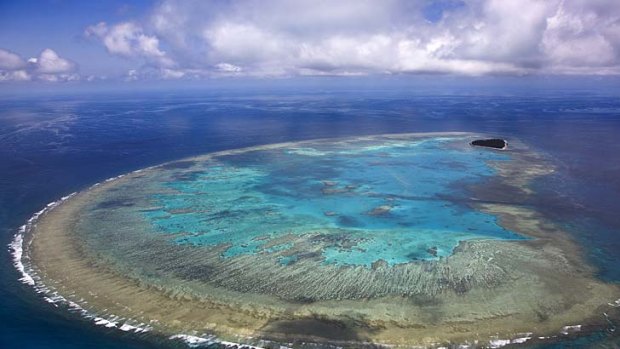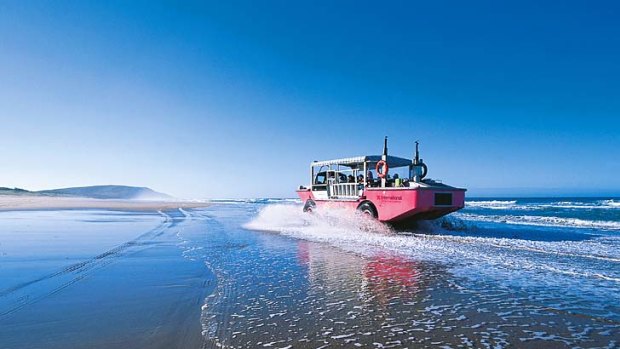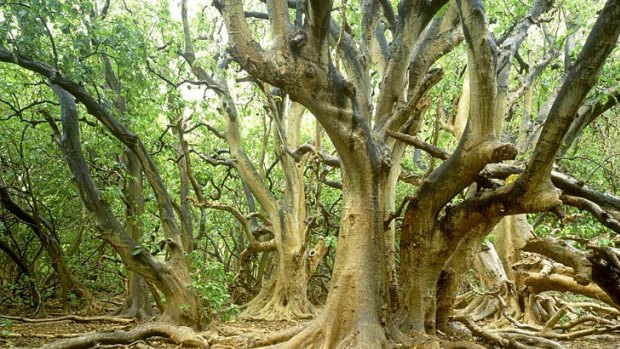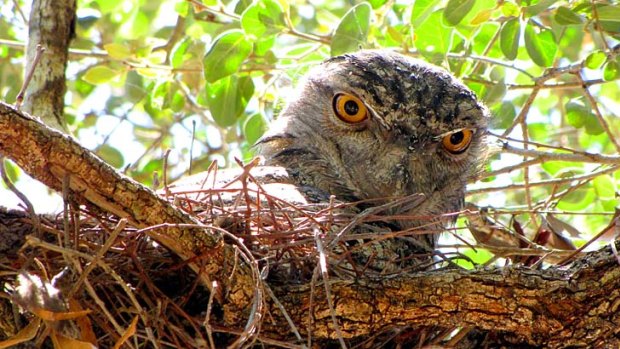
Remote access... Lady Musgrave Island looks like a scene from Pirates of the Caribbean.Credit: Getty Images
Keith Austin falls hard for Queensland's Lady Musgrave Island and its nearby towns of Agnes Water and 1770.
One hour and 15 minutes after setting off from the tiny marina at the Town of 1770, Lady Musgrave Island comes into view and, as the ocean gradually turns from deep-water blue to that turquoise colour you expect to see only in movies, becomes a real-life desert island. It's a green dot (14 hectares in area and eight kilometres in circumference) in a crystal-clear lagoon surrounded by reef and ringed by golden-white sand. It truly is ridiculously, gobsmackingly cliched. You think: Johnny Depp should be staggering along this beach as Captain Jack Sparrow.
As our 22-metre catamaran, the Spirit of 1770, chugs into the lagoon and moors at the pontoon, the crew throw food pellets overboard. Suddenly the water is a kaleidoscope of tropical fish. A few eager beavers slip straight into the snorkelling gear provided and into the water. We board a glass-bottom boat and see a small manta ray and a turtle as we head ashore. The sand squeaks as we walk past a sign that declares we are in the Capricornia Cays National Park.

Wet, wet, wet... aboard an amphibious vessel.
On a gravel path, dozens of black noddies rest in the sun. Ahead is a dense pisonia tree forest in which roost 40,000 or so birds, including wedge-tailed shearwaters and burrowing muttonbirds. Raucous bird call is all around but it's only when we get into the trees that the smell hits us. Noddies make crap nests - literally - collecting leaves and debris and binding it with their poo.
Birds whizz death-defyingly around our heads. According to our guide half will die, killed by the very trees in which they nest: "The trees' seeds are like superglue and they stick to the birds' feathers so they can't fly. It's why the soil here is so rich." In the afternoon, back at the pontoon, all remains sickeningly, marvellously perfect.
Snorkelling the coral reefs, watching hypnotically flickering fish in the sunlight-dappled lagoon (without stinger suits, as the little buggers don't often drift this far south), a buffet lunch of prawns, cold meats, tea, coffee and lamingtons, a pootle in a semi-submarine ("please don't open the windows"), watching the action from its observatory ... Really, you don't need to hear any more of this, do you?

Pisonia forest is home to about 40,000 birds.Credit: Getty Images
When Lieutenant James Cook sailed the east coast in the HMS Bark Endeavour naming everything in sight, he had obviously run out of inspiration by the time he reached what would become Queensland. After sighting a large, round hill, Cook and crew steered into a bay in search of water and provisions. In said bay were bustard birds. They shot one, ate it and named the place Bustard Bay.
Around that gum tree-laden headland today sits the Town (more of a village, really) of 1770, renowned as the birthplace of Queensland.
There's even a marker cairn to prove it.

Nesting... a tawny frogmouth.Credit: Keith Austin
Overlooking the area where Cook came ashore, it's easy to imagine the scenario that played out on the Endeavour:
"What year is it, Hickes?" yells Cook to one of his men.
"The year of Our Lord 1770, sir!"
"Then we shall name this place ... Round Hill."
Indeed, the Town of 1770 has only been called such since 1970 when the prosaically named Round Hill was rechristened to commemorate the bicentennial of Cook's visit. But what's in a name? Cook could have called it Smelly Armpit (they had been at sea for a while) and the place would still be a piece of unspoilt paradise at the tail end of the Great Barrier Reef.
Surrounded by the Coral Sea and Bustard Bay, 1770 - with its sister village of Agnes Water a few kilometres south - is a pristine tourism destination lacking one thing: tourists. There's a reason for this, which I will explain later*.
In three days I encounter red-tailed black cockatoos, a tawny frogmouth, pied oystercatchers, red-capped plovers, a host of small manta rays, a hilarious, skittering army of soldier crabs, ospreys, kites, gull-billed terns, dolphins, turtles, the aforementioned black noddies, white-capped terns, an inquisitive greasy cod, tropical fish galore, wallabies, and a German backpacker with no arm strength (not an ideal companion in a two-person kayak). I ride offshore waves and search for dolphins and surf a sand dune. I join a tour from Agnes Water to 1770 and back by electric bicycle, led by wildlife expert and bushtucker man Marcus Webber.
It helps to have Webber with you. We certainly wouldn't have seen the tawny frogmouth owl nesting above us without his guidance, so well camouflaged was it among tree branches (and before you write in, no, it's not strictly an owl). Webber also points out the types of plants local indigenous Australians cook, plants best avoided unless you want to die (certain bits of the wombat berry, if you must know), those that can double as hairbrushes (the nuts from the banksia tree) and those that are good to chew for water. The melaleuca, for instance, is evidence of water underground, while certain species of it are better known as paperbarks or the tea tree, from whence comes the oil. If you like that sort of stuff.
We take a LARC tour of the Eurimbula National Park across Bustard Bay from 1770. The LARC is a Lighter Amphibious Resupply Cargo vessel, made of aluminium and built in the mid-1960s by the US Army.
Part minibus, part boat, our vessel is called the Dr Daniel Solander (who was on the Endeavour with Cook) and is painted pink. It carries 32 people and is one of two LARCS that ply this section of coastline (the other is the Sir Joseph Banks).
We set off from the 1770 marina feeling an odd surge of excitement and a little fear as the "bus" drives into the water and bobs past sandbars adorned with pied oystercatchers, cormorants, silver gulls and red-capped plovers. (Not that I would know a red-capped plover from a dead noddy but our guide is knowledgable and keeps everyone informed and entertained.)
Once across the bay, we drive onto the sand below the high-tide mark to avoid interfering with nesting seabirds or turtles, and to ensure our tracks are washed away with the next tide before we trundle towards Bustard Head Lightstation.
Later, we "surf" the easy side of a dune, then the "big dipper": shoes off, boogie board in hand, push off - and suddenly you're plummeting and skimming across the sand until, wumph, you're shooting out across the aquamarine water like a rocket. It's exhilarating, refreshing, nerve-racking and everyone on the national park tour who does it comes away with a smile. Should you like that sort of stuff.
That evening after we return to 1770, I pop into The Tree pub and restaurant and, with geckos chittering on the walls, have a beer as the sun goes down in yet another pastel-coloured riot - the death of another day in paradise. If you like that sort of stuff.
*Seriously, don't go. It's rubbish there. Stay away - leave it all for me.
Keith Austin travelled to 1770 and Agnes Water courtesy of Tourism Queensland.
FAST FACTS
Getting there Qantas (qantas.com.au) and Virgin Australia (virginaustralia.com) fly from Melbourne and Sydney to Gladstone via Brisbane. Cars can be hired at Gladstone airport for the two-hour drive to Agnes Water-Town of 1770 along the Bruce Highway (turn off at Miriam Vale).
Staying there
Sandcastles 1770 Motel and Resort in Agnes Water has rooms from $110 a night; apartments from $200 a night. Phone (07) 4974 9428; see sandcastles1770.com.au.
LaLaLand Guesthouses, Bicentennial Drive, Agnes Water, has cottages from $155 a night for two people. See lalaland1770aw.com.au.
The Town of 1770 Caravan and Camping Ground is on the water's edge and has powered and unpowered sites. See 1770campinggrounds.com.
While there
LARC Paradise Tours operate every Monday, Wednesday and Saturday (more often during school holidays), departing 1770 at 9am and returning about 4pm. Tickets $153 adults, $93 children. Includes morning tea, picnic lunch, sandboarding and a tour of Bustard Head Light. One-hour sunset tours operate daily depending on demand. See 1770larctours.com.au.
A Discover 1770 Electric Bike Tour ($49 adults, $35 children) departs daily from Agnes Beach Bicycles, next to the Caltex service station. Phone (07) 4974 7557; or see discover1770.com.au.
Kayaking with 1770 Liquid Adventures includes a daily sunset tour, from $55 (with drinks and snacks), weather permitting. See 1770liquidadventures.com.au.
Lady Musgrave Cruises operates a high-speed catamaran from the 1770 marina at 8.30am (8am check-in), returning about 5pm. Day cruises cost $180 an adult ($165 for seniors and students). Children aged 4-14 are $85. Family packages available. See lmcruises.com.au.
Eating there
The Agnes Water Tavern is a barn of a place with good bistro food, a great wraparound wooden deck, pool tables and friendly service. See agnestavern.com.au.
The Tree Restaurant at 1770 Beach Hotel on Captain Cook Drive, 1770, has a good menu, excellent service and a stunning view of the beach. See restaurant1770.com.
Bustards Restaurant, Agnes Street, Agnes Water, is a good choice for a relaxing lunch. Try the battered fish and chips. Real value for money. Phone (07) 4974 7675.
Kahunas Pizza, Bar and Grill at the Sandcastles Resort is the local place for a pizza. Phone (07) 4974 7033.
More information
Sign up for the Traveller Deals newsletter
Get exclusive travel deals delivered straight to your inbox. Sign up now.